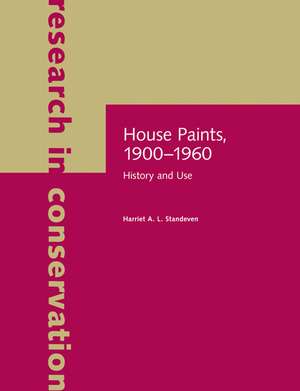House Paints, 1900-1960: History and Use: Research in Conservation
Autor Harriet A. L. Standevenen Limba Engleză Paperback – 25 mai 2011
The versatility of modern commercial house paints has ensured their use in a broad range of applications, including the protection and decoration of historic buildings, the coating of toys and furniture, and the creation of works of art. Historically, house paints were based on naturally occurring oils, gums, resins, and proteins, but in the early twentieth century, the introduction of synthetic resins revolutionized the industry. Good quality ready-mixed products became available and were used by artists worldwide.
While the ubiquity of commercial paints means that conservators are increasingly called upon to preserve them, such paints pose unique challenges including establishing exactly which materials are present.
This book traces the history of the household paint industry in the United States and United Kingdom over the first half of the twentieth century. It includes chapters on the artistic use of commercial paints and the development of ready-mixed paints and synthetic resins; oil paints, oleoresinous gloss and enamel paints, water paints, nitrocellulose lacquers, oil-modified alkyds, and emulsion paints; and the conservation implications of these materials. The book will be of interest to conservators and conservation scientists working on a broad range of painted surfaces, as well as curators, art historians, and historians of architectural paint.
While the ubiquity of commercial paints means that conservators are increasingly called upon to preserve them, such paints pose unique challenges including establishing exactly which materials are present.
This book traces the history of the household paint industry in the United States and United Kingdom over the first half of the twentieth century. It includes chapters on the artistic use of commercial paints and the development of ready-mixed paints and synthetic resins; oil paints, oleoresinous gloss and enamel paints, water paints, nitrocellulose lacquers, oil-modified alkyds, and emulsion paints; and the conservation implications of these materials. The book will be of interest to conservators and conservation scientists working on a broad range of painted surfaces, as well as curators, art historians, and historians of architectural paint.
Preț: 330.78 lei
Preț vechi: 389.00 lei
-15% Nou
Puncte Express: 496
Preț estimativ în valută:
63.30€ • 68.74$ • 53.17£
63.30€ • 68.74$ • 53.17£
Carte indisponibilă temporar
Doresc să fiu notificat când acest titlu va fi disponibil:
Se trimite...
Preluare comenzi: 021 569.72.76
Specificații
ISBN-13: 9781606060674
ISBN-10: 1606060678
Pagini: 176
Ilustrații: 11 color and 8 b-w illustrations
Dimensiuni: 216 x 279 x 15 mm
Greutate: 0.66 kg
Ediția:1
Editura: Getty Publications
Colecția Getty Conservation Institute
Seria Research in Conservation
ISBN-10: 1606060678
Pagini: 176
Ilustrații: 11 color and 8 b-w illustrations
Dimensiuni: 216 x 279 x 15 mm
Greutate: 0.66 kg
Ediția:1
Editura: Getty Publications
Colecția Getty Conservation Institute
Seria Research in Conservation
Recenzii
“The conservation of household paint is an under-researched area. This book provides a discussion of the chemical composition of these ubiquitous materials, their characteristics, and weakness and will be of great assistance to all conservators as an important reference book.”—ICON News
“It is a brave person who attempt to tackle the subject of twentieth-century household paints and Harriet Standeven has done a magnificent job. . . . I am not aware of any other work that covers the same ground.”—Journal of Architectural Conservation
Notă biografică
Harriet A.L. Standeven is a freelance conservator specializing in the care of modern and contemporary art.
